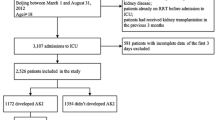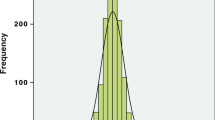Abstract
Background
Fluid accumulation may delay recognition of acute kidney injury (AKI) in intensive care unit (ICU) patients. This study aims to evaluate the impact of fluid balance on the incidence, time of AKI diagnosis and predictive performance for outcomes of critically ill patients.
Methods
This study included a cohort of 7696 adult ICU patients at Mayo Clinic Hospital in year 2011 with at least one serum creatinine (SCr) measured in ICU. AKI was defined based on SCr criterion for stage I of KDIGO definition. The AKI incidence and predictive performance for 60-day mortality was compared before and after SCr adjustment for fluid balance.
Results
AKI was detected in 1860 (24.2 %) before and 1947 (25.3 %) after fluid balance adjustment (P < 0.001). Patients with AKI both before and after SCr adjustment had significantly higher 60-day mortality in comparison with patients who did not develop AKI (OR 3.38; 95 % CI 2.84–4.02). The risk of 60-day mortality in patients who met AKI criteria after but not before SCr adjustment was significantly higher than patients without AKI (OR 2.00; 95 % CI 1.25–3.11). In contrast, the risk of 60-day mortality in patients who met AKI criteria before but not after SCr adjustment was similar to patients without AKI (OR 1.19; 95 % CI 0.48–2.50). The C-statistic for unadjusted and adjusted SCr to predict 60-day mortality were 0.68 and 0.70, respectively (P = 0.001).
Conclusion
Our study found that SCr adjustment for fluid balance could result in a more accurate detection of AKI cases. We suggest using fluid balance adjustment for volume overload critically ill patients.


Similar content being viewed by others
References
KDIGO AKI Work Group (2012) KDIGO clinical practice guidelines for acute kidney injury. Kidney Int suppl 2:1–138
Srisawat N, Kellum JA (2011) Acute kidney injury: definition, epidemiology, and outcome. Curr Opin Crit Care 17:548–555
Chertow GM, Burdick E, Honour M, Bonventre JV, Bates DW (2005) Acute kidney injury, mortality, length of stay, and costs in hospitalized patients. J Am Soc Nephrol 16:3365–3370
Ricci Z, Cruz D, Ronco C (2008) The RIFLE criteria and mortality in acute kidney injury: a systematic review. Kidney Int 73:538–546
Ricci Z, Cruz DN, Ronco C (2011) Classification and staging of acute kidney injury: beyond the RIFLE and AKIN criteria. Nat Rev Nephrol 7:201–208
Thongprayoon C, Cheungpasitporn W, Akhoundi A, Ahmed AH, Kashani KB (2014) Actual versus ideal body weight for acute kidney injury diagnosis and classification in critically Ill patients. BMC Nephrol 15:176
Susantitaphong P, Cruz DN, Cerda J et al (2013) World incidence of AKI: a meta-analysis. Clin J Am Soc Nephrol 8:1482–1493
Bellomo R, Ronco C, Kellum JA, Mehta RL, Palevsky P (2004) Acute renal failure—definition, outcome measures, animal models, fluid therapy and information technology needs: the Second International Consensus Conference of the Acute Dialysis Quality Initiative (ADQI) Group. Crit Care 8:R204–R212
Mehta RL, Kellum JA, Shah SV et al (2007) Acute Kidney Injury Network: report of an initiative to improve outcomes in acute kidney injury. Crit Care 11:R31
Lassnigg A, Schmidlin D, Mouhieddine M et al (2004) Minimal changes of serum creatinine predict prognosis in patients after cardiothoracic surgery: a prospective cohort study. J Am Soc Nephrol 15:1597–1605
Koyner JL, Bennett MR, Worcester EM et al (2008) Urinary cystatin C as an early biomarker of acute kidney injury following adult cardiothoracic surgery. Kidney Int 74:1059–1069
Bellomo R, Raman J, Ronco C (2001) Intensive care unit management of the critically ill patient with fluid overload after open heart surgery. Cardiology 96:169–176
Liu KD, Thompson BT, Ancukiewicz M et al (2011) Acute kidney injury in patients with acute lung injury: impact of fluid accumulation on classification of acute kidney injury and associated outcomes. Crit Care Med 39:2665–2671
Macedo E, Bouchard J, Soroko SH et al (2010) Fluid accumulation, recognition and staging of acute kidney injury in critically-ill patients. Crit Care 14:R82
Levey AS, Stevens LA, Schmid CH et al (2009) A new equation to estimate glomerular filtration rate. Ann Intern Med 150:604–612
Knaus WA, Wagner DP, Draper EA et al (1991) The APACHE III prognostic system. Risk prediction of hospital mortality for critically ill hospitalized adults. Chest 100:1619–1636
Ferreira FL, Bota DP, Bross A, Melot C, Vincent JL (2001) Serial evaluation of the SOFA score to predict outcome in critically ill patients. JAMA 286:1754–1758
Wentworth DN, Neaton JD, Rasmussen WL (1983) An evaluation of the Social Security Administration master beneficiary record file and the National Death Index in the ascertainment of vital status. Am J Public Health 73:1270–1274
Hoste EA, Clermont G, Kersten A et al (2006) RIFLE criteria for acute kidney injury are associated with hospital mortality in critically ill patients: a cohort analysis. Crit Care 10:R73
Coca SG, Peixoto AJ, Garg AX, Krumholz HM, Parikh CR (2007) The prognostic importance of a small acute decrement in kidney function in hospitalized patients: a systematic review and meta-analysis. Am J Kidney Dis 50:712–720
Weisbord SD, Palevsky PM (2006) Acute renal failure in the intensive care unit. Semin Respir Crit Care Med 27:262–273
Fliser D, Laville M, Covic A et al (2012) A European Renal Best Practice (ERBP) position statement on the Kidney Disease Improving Global Outcomes (KDIGO) clinical practice guidelines on acute kidney injury: part 1: definitions, conservative management and contrast-induced nephropathy. Nephrol Dial Transplant 27:4263–4272
Odden MC, Shlipak MG, Tager IB (2009) Serum creatinine and functional limitation in elderly persons. J Gerontol A Biol Sci Med Sci 64:370–376
Englberger L, Suri RM, Li Z et al (2011) Clinical accuracy of RIFLE and Acute Kidney Injury Network (AKIN) criteria for acute kidney injury in patients undergoing cardiac surgery. Crit Care 15:R16
Ho J, Reslerova M, Gali B et al (2012) Serum creatinine measurement immediately after cardiac surgery and prediction of acute kidney injury. Am J Kidney Dis 59:196–201
Bouchard J, Soroko SB, Chertow GM et al (2009) Fluid accumulation, survival and recovery of kidney function in critically ill patients with acute kidney injury. Kidney Int 76:422–427
Plataki M, Kashani K, Cabello-Garza J et al (2011) Predictors of acute kidney injury in septic shock patients: an observational cohort study. Clin J Am Soc Nephrol 6:1744–1751
Bagshaw SM, Uchino S, Bellomo R et al (2007) Septic acute kidney injury in critically ill patients: clinical characteristics and outcomes. Clin J Am Soc Nephrol 2:431–439
Yunos NM, Bellomo R, Hegarty C, Story D, Ho L, Bailey M (2012) Association between a chloride-liberal vs chloride-restrictive intravenous fluid administration strategy and kidney injury in critically ill adults. JAMA 308:1566–1572
Devarajan P (2008) Neutrophil gelatinase-associated lipocalin (NGAL): a new marker of kidney disease. Scand J Clin Lab Invest Suppl 241:89–94
Matsui K, Kamijo-Ikemorif A, Sugaya T, Yasuda T, Kimura K (2011) Renal liver-type fatty acid binding protein (L-FABP) attenuates acute kidney injury in aristolochic acid nephrotoxicity. Am J Pathol 178:1021–1032
Han WK, Bailly V, Abichandani R, Thadhani R, Bonventre JV (2002) Kidney injury molecule-1 (KIM-1): a novel biomarker for human renal proximal tubule injury. Kidney Int 62:237–244
Kashani K, Al-Khafaji A, Ardiles T et al (2013) Discovery and validation of cell cycle arrest biomarkers in human acute kidney injury. Crit Care 17:R25
Conflict of interest
None.
Ethical standards
All procedures performed in this study involving human participants were in accordance with the ethical standards of the institutional and/or national research committee and with the 1964 Helsinki declaration and its later amendments or comparable ethical standards.
Informed consent
Informed consent was obtained from all individual subjects included in the study.
Author information
Authors and Affiliations
Corresponding author
Electronic supplementary material
Below is the link to the electronic supplementary material.
Rights and permissions
About this article
Cite this article
Thongprayoon, C., Cheungpasitporn, W., Srivali, N. et al. The impact of fluid balance on diagnosis, staging and prediction of mortality in critically ill patients with acute kidney injury. J Nephrol 29, 221–227 (2016). https://doi.org/10.1007/s40620-015-0211-3
Received:
Accepted:
Published:
Issue Date:
DOI: https://doi.org/10.1007/s40620-015-0211-3




